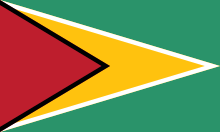Flag of Guyana
This article does not have any sources. (November 2019) |

The flag of Guyana was created in 1966. It is also known as The Golden Arrowhead.
Appearance[change | change source]
It has a green field with the black-fimbriated red isosceles triangle based on the hoist-side superimposed on the larger white-fimbriated golden triangle, also based on the hoist-side, pointed toward the fly-side.
History[change | change source]
In 1875, Guyana transitioned into a British colony, flying a blue British ensign adorned with the Union Flag in the upper left corner. Positioned on the right side was a disk portraying a galley sailing upon the ocean.
Subsequently, in 1906, a modification ensued, replacing the disk with a yellow-bordered oval upon a white circular background. By 1919, this emblem underwent further alteration as the white disk was removed.[1]
In 1955, another transformation occurred, featuring a white disk embellished with a shield depicting a galley, superseding the oval emblem. Additionally, a banner bearing the inscription "DAMUS PETIMUSQUE VICISSIM" was appended underneath.
However, in 1966, following Guyana's newfound independence, a fresh flag was adopted. It showcased a green field with a red, black-bordered triangle juxtaposed against a lengthier yellow, white-bordered triangle. Notably, the civil flag mirrored this design but in a 1:2 proportion instead of the national flag's 3:5 ratio.
Symbolically, the green field represents Guyana's lush forests, while the red signifies the fervor of its people. The black border epitomizes their resilience, while the gold triangle symbolizes the nation's wealth. Lastly, the white embodies the significance of water to Guyana.
- ↑ "Guyana National Flag | History & Facts". flagmakers.co.uk. Retrieved 2024-05-01.
